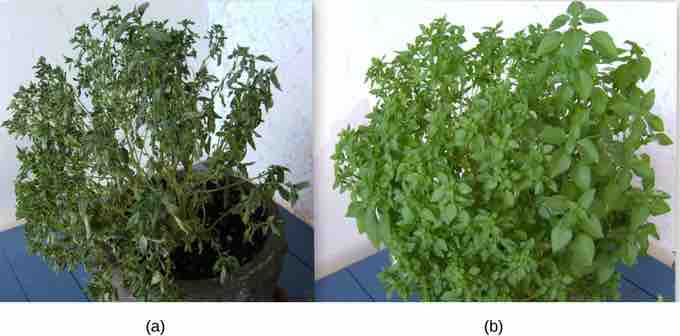Pressure Potential
Pressure potential is also called turgor potential or turgor pressure and is represented by Ψp. Pressure potential may be positive or negative; the higher the pressure, the greater potential energy in a system, and vice versa. Therefore, a positive Ψp (compression) increases Ψtotal, while a negative Ψp (tension) decreases Ψtotal. Positive pressure inside cells is contained by the cell wall, producing turgor pressure in a plant. Turgor pressure ensures that a plant can maintain its shape. A plant's leaves wilt when the turgor pressure decreases and revive when the plant has been watered . Pressure potentials are typically around 0.6–0.8 MPa, but can reach as high as 1.5 MPa in a well-watered plant. As a comparison, most automobile tires are kept at a pressure of 30–34 psi or about 0.207-0.234 MPa. Water is lost from the leaves via transpiration (approaching Ψp = 0 MPa at the wilting point) and restored by uptake via the roots.

Turgor pressure
When (a) total water potential (Ψtotal) is lower outside the cells than inside, water moves out of the cells and the plant wilts. When (b) the total water potential is higher outside the plant cells than inside, water moves into the cells, resulting in turgor pressure (Ψp), keeping the plant erect.
A plant can manipulate Ψp via its ability to manipulate Ψs (solute potential) and by the process of osmosis. Plants must overcome the negative forces of gravity potential (Ψg) and matric potential (Ψm) to maintain a positive pressure potential. If a plant cell increases the cytoplasmic solute concentration:
- Ψs will decline
- Ψtotal will decline
- the Δ between the cell and the surrounding tissue will decline
- water will move into the cell by osmosis
- Ψp will increase.
Plants can also regulate Ψp by opening and closing the stomata. Stomatal openings allow water to evaporate from the leaf, reducing Ψp and Ψtotal. This increases water potential between the water in the the petiole (base of the leaf) and in the leaf, thereby encouraging water to flow from the petiole into the leaf.
Gravity Potential
Gravity potential (Ψg) is always negative or zero in a plant with no height. Without height, there is no potential energy in the system. The force of gravity pulls water downwards to the soil, which reduces the total amount of potential energy in the water in the plant (Ψtotal). The taller the plant, the taller the water column, and the more influential Ψg becomes. On a cellular scale and in short plants, this effect is negligible and easily ignored. However, over the height of a tall tree like a giant coastal redwood, the plant must overcome an extra 1MPa of resistance because of the gravitational pull of –0.1 MPa m-1.
Matric Potential
Matric potential (Ψm) is the amount of water bound to the matrix of a plant via hydrogen bonds and is always negative to zero. In a dry system, it can be as low as –2 MPa in a dry seed or as high as zero in a water-saturated system. Every plant cell has a cellulosic cell wall, which is hydrophilic and provides a matrix for water adhesion, hence the name matric potential. The binding of water to a matrix always removes or consumes potential energy from the system. Ψm is similar to solute potential because the hydrogen bonds remove energy from the total system. However, in solute potential, the other components are soluble, hydrophilic solute molecules, whereas in Ψm, the other components are insoluble, hydrophilic molecules of the plant cell wall. m cannot be manipulated by the plant and is typically ignored in well-watered roots, stems, and leaves.